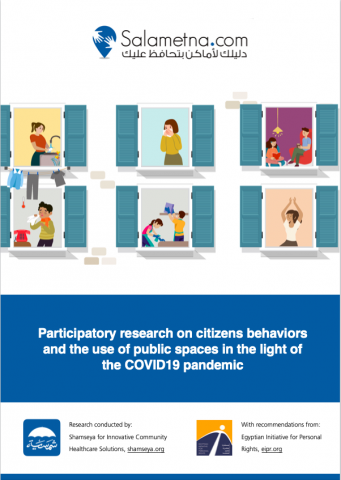Participatory Research on the Use of Public Spaces in light of the COVID19 Epidemic and citizens’ reactions to new official policies
Abstract
In response to the COVID-19 pandemic, Shamseya conducted this study to investigate the response to and level of worry of the community about the virus. This research also investigates the infection control measures taken by public spaces to limit transmission. We also present a brief reflection about the curfew measures based on the data we collected and through the lens of efficiency and equity.
For the community response, 464 responses were collected. The commitment of different groups to self isolation, level of worry, reasons for going out were measured.
For the public spaces, 6 service providers answered a questionnaire regarding their views on the curfew policy implemented on the 25th of March 2020.
Data was also collected from salametna.com, a website that publishes ratings and assessments of public spaces based on infection control measures.
The purpose of these investigations is to provide relevant stakeholders and authorities with data regarding the community in order to better shape policy and decision making.
The results of the study show that income levels played a significant role in the level of worry of citizens and commitment to self isolation. The age group 45-60, though one of the most vulnerable to the virus, is the least committed to self isolation. As for service providers, the safety measure least taken is measuring temperature of guests and adequate aeration of the space. In our analysis we provide some context and hypothesis for these findings and relate them to the national as well as the international setting.
Finally, curfew measures should not be implemented and evaluated narrowly, as an individual policy detached from its surroundings, but in the context of parallel accompanying policies reducing its harm and promoting its good.
The study provides recommendations by the Right to Health Program of the Egyptian Initiative for Personal Rights. These recommendations are for relevant authorities, the most important of which is to transparently make accurate information available, disaggregated especially by geographical division of infection rates and available numbers of clinical tests.
Other updated information to be shared with society is the current needs and shortcomings of the government.
The state should also put in place mechanisms that achieve equity for the most economically vulnerable groups, apply clear criteria to combat infection in health facilities, motivate/incentivize health facilities to follow them in preparation for accreditation from the General Authority for Health Accreditation and Regulations, and provide broader protection in all medical services for the elderly and prioritize them, through the law, in places of public services such as government departments, banks, and relevant services.
Finally, the study recommends supporting and encouraging cooperation with civil society and private sector initiatives and providing them with information to carry out projects and initiatives that represent a real need in line with national priorities, to allow society to work hand in hand with the government and to participate in carrying the burden of the response.
B. General Context
Corona virus and the current situation
The World Health Organization (WHO) announced on Wednesday (March 11th 2020) the coronavirus as a global pandemic after achieving a widespread outbreak. That declaration sparked a wide range of measures and policies at the national and global levels aimed at reducing the spread of the virus and reducing its harmful effects on public health and the health systems. In Egypt, these measures began on March 16 with the announcement by the Egyptian Prime Minister to reduce the number of employees in government agencies to reduce friction between citizens, and suspend all Egyptian airports and studies in schools and universities, and then a package of more restrictive measures, which included early closure of public places and then a curfew.
Social responsibility
Due to the rapid spread of the virus, it has become necessary to apply unprecedented and exceptional measures. These efforts require the cooperation of all social stakeholders in a coordinated manner to achieve the desired goals. The spread of the virus in many countries has exceeded the capabilities of the traditional health system and has negatively affected government plans to reduce its harm to health. It has become clear to decision makers that citizens should be empowered with tools to help them confront the virus, reduce its losses and transforming them from disease victims to active parties capable of suggesting and implementing solutions.
C. Research aims
- This research aims to find prompt answers to the following questions:
- How familiar is the public with the COVID-19 epidemic and how concerned or worried are they about infection?
- To what extent do citizens apply self-isolation?
- Are citizens leaving their homes? Why? when? And to where?
- How did the decision to close public places at night affect the behavior of citizens?
- How do social determinants (such as age, place of residence, level of income, and nature of work) affect citizens' actions and decisions?
- To what extent have employees and officials in public places implemented infection control measures and what difficulties have they encountered in this?
- To what extent is the curfew policy efficient and fair? and what’s next?
D. Research Methodology
1. The quantitative component
This study rests an extensive quantitative methodology that included a sample of citizens with the aim of representing geographical locations, income level, age groups, and the various types of businesses at the national level.
2. Research tool
A brief questionnaire was developed that can be published and used online and through direct interviews and via telephone conversations. This questionnaire can be found through this link:
https://docs.google.com/forms/u/1/d/e/1FAIpQLSdUKrcZIM_obdRhk39btuGsy6fu...
Duration of research / timeframe
Participants answered the questionnaire in the week between March 19 and March 26, 2020.




